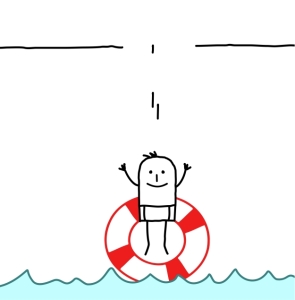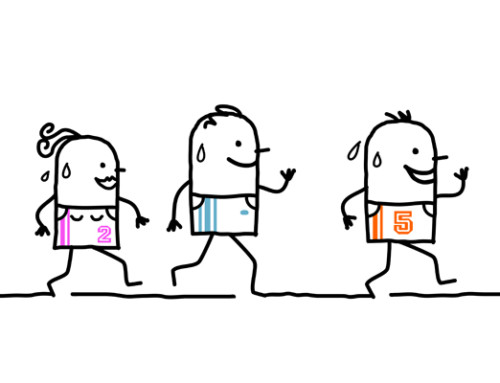In this article, I discuss what I learned about setting and pursuing goals from a recent experience in doing so.
Estimated reading time: 8 minutes.
I recently returned from Penticton, British Columbia where I was competing in the Skaha Lake Ultra Swim. This is an 11.8 kilometer event in which participants begin at one end of Skaha Lake and swim the length of the lake to a beach at the other end. Each participant swims alongside their ‘paddling partner’ in a kayak who guides them and hands them food and drink for fueling at certain time intervals during the event.
I had originally set the goal of doing the Ultra Swim in 2020. Unfortunately, the pandemic resulted in it being postponed—first until 2021 and again until it finally took place on August 7, 2022. Once it became clear that the swim would take place in 2022, I prepared for the event with several months of intensive training.
The experience of training for and ultimately competing in the event taught me some lessons regarding setting and pursuing goals. In particular, I became more aware of the importance of weighing the benefits and costs in choosing which goals to pursue. I will share my thoughts on these matters in the following sections.
Setting my Ultra Swim goals
In setting my goals for the Ultra Swim, I focused on the SMART acronym—that goals should be specific, measurable, attainable, realistic and time-limited. The goals I set which adhered to these criteria included completing the 11.8 kilometer swim on August 7, 2022 and doing so in a time of under 4 hours.
Both of these goals were specific, measurable and time-limited. I also determined that these goals were attainable and realistic. I made this conclusion based on my level of fitness and on having a training program a friend had given me with workouts designed to achieve both my goals.
It is important to note that although the goals I set were attainable and realistic, it was not certain whether I would be able to achieve them. The reason for this is that in order for the pursuit of goals to lead to energy, excitement and passion they must be challenging. Goals which are too easy will not produce this energy, excitement and passion. On the other hand, if the goals are seen as too challenging to be attainable and realistic, the person is likely to give up on the pursuit because they will lack the motivation to continue an endeavor which they view as an exercise in futility.
The benefits of pursuing and achieving my goals
Setting SMART goals for the Ultra Swim set in motion several benefits—some ongoing and some potential. These included:
(1) The ongoing passion, energy and excitement of engaging in activities in pursuit of my goals:
(2) Enjoying a regular boost to my self-esteem by completing the challenging workouts necessary to move me toward the achievement of my goals:
(3) Once the UltraSwim took place, the prospect of making significant athletic achievements in which I can take pride for the rest of my life/
The prospect of attaining these significant benefits provided me with the motivation needed to endure the costs necessary to attain them.
The costs of pursuing and achieving my goals
The costs of pursuing my goals included:
(1) A physically demanding training schedule comprised of pool and lake swims, some of which focused on building endurance through swims of increasingly long distance and others which increased my ability to swim faster with up-tempo interval swims. Along with strength and abdominal workouts away from the water, this training regimen of over four months would prove to be physically and emotionally draining;
(2) The stress associated with various ‘hassles’ involved in trying to complete workouts at a public pool. Each day when I drove to Calgary’s MNP Centre where I did my pool swims I faced the stress of not knowing whether I would be able to find a lane in which to complete my workout.
Some days were fine in this regard. Unfortunately, on many other days I faced challenges including having one or more other swimmers in my lane, having to wait a substantial amount of time before a lane became available, and being ‘evicted’ from a lane by a pool lifeguard informing me that my lane was required for use by a group who had booked it. The latter scenario occurred multiple times despite my having checked with a lifeguard that my lane would not be required for use by a group.
These hassles often could have been decreased by MNP Center staff opening up additional pool space for public lane swimming. Unfortunately, I was informed by MNP Center management that they did not want to pay additional lifeguards for this purpose.
(3) The stress leading up to competing. As race day approached, the stress would increase in anticipation of having to perform. Additional competition stresses would include making sure I had all the food, liquids and equipment I would need for the race. For example, I ordered tinted prescription swim goggles from Florida because none were available in Calgary. I had to buy five new insulated bike bottles in advance of the race to keep my fluids cool over several hours. I also had to borrow a life jacket to be stored on the kayak.
Speaking of the kayak, once I arrived in Penticton a few days before the race I arranged to meet with my paddler to go over details such as how often she would stop me for fueling breaks and what to hand me on those breaks. I also had to become familiar with the race start area and tasks to accomplish on race morning so that I would know where to go and what to do on race morning.
Speaking of race morning, the stress heightened at that point as I rose at 3:40 am to ensure that I would get done what needed to be done in my motel room so that I would arrive at the race site by 5:30 am. This included showering, having breakfast and ensuring that every item I needed to bring with me was in one of my bags.
Once at the race site, I had to get several other things done leading up to the 7:00 am start. This included finding a place to park, going to the washroom, picking up my athlete number for the kayak, putting on my wetsuit and asking a stranger to zip it up for me (it zips up in the back), connecting with my paddler to give her my life jacket and fuel-filled bag, helping my paddler move the kayak into the water and looking for the start area.
(4) The stress of the race itself. When the race began, all the pre-event stress was behind me, only to be replaced by the stress of doing the swim. Compared with the pre-race stress, the stress from doing the race was much easier to manage.
There was the obvious stress stemming from having to swim at a fast pace for 11.8 kilometers over several hours. However, my having trained properly meant that keeping up a good pace was well within my ability. Every 30 minutes during the event my paddler would wave her yellow hat to signal me it was time for a break when she would hand me food and fluids.
As the race progressed, I continued to feel strong and swam at a steady pace. I grew increasingly confident that I would be able to achieve my goal of completing the 11.8 kilometer distance and felt excitement that my finishing the event in my sub-4 hour goal time was possible.

The result and the aftermath: Did the benefits of pursuing my goals exceed the costs?
I eventually saw the finish line from a distance and determined that I would not only be able to complete my goal of finishing the swim, I was also going to accomplish my goal of finishing in under 4 hours. The feeling of elation I experienced at this time—which continued as I crossed the finish line—was indescribable. I had finished the race in 3 hours, 48 minutes and 25 seconds to get under my time goal by a wide margin.
At that moment and in the hours, days and weeks following the race, I determined that all the costs of pursuing my goals had been worth it. The costs which I described and the stress stemming from them were indeed substantial. However, the benefit of feeling so wonderful at having accomplished my goals led me to conclude that they were necessary in order to reap this and the other benefits I described.
Deciding whether to do the Ultra Swim again: More cost-benefit analysis
Deciding whether I would choose to train for and compete in the Skaha Lake Ultra Swim again depends on the results of a cost-benefit analysis of pursuing the goals which I would set for the event. For the event which I just completed, there was the potential that the benefits of pursuing my goals would exceed the costs. This provided me with the motivation needed to endure these costs. Therefore, it would make sense to do the event again only if there is again the potential that the benefits of pursuing my goals would exceed the costs.
These ‘motivating’ potential benefits would be present in my case if the goal of completing the Ultra Swim in a better time than my time at this year’s event would be attainable and realistic. I don’t know at this point whether such a goal is attainable and realistic. This would depend on whether I am capable of completing a training program intended to achieve a better finishing time than my time at this year’s event. I plan to consult with experts such as coaches to find out if this is possible.
Even if it were possible to achieve this goal, I would have to think long and hard about whether I wish to endure the substantial costs which are necessary to achieve it. I may decide to move on to the pursuit of goals in a different area from long distance swimming, content with the knowledge that I have already achieved goals in this area.
Thank you to people who helped me achieve my Ultra Swim goals
I want to thank several people who helped me to achieve my goals at this year’s Skaha Lake Ultra Swim. This includes:
(1) Fellow lake swimmer Janice Kennedy, having completed the Ultra Swim many times, gave me invaluable advice and provided me with a swim workout program. I followed this program to the letter and it paid off in being able to complete the 11.7 kilometer distance in a time which exceeded my goal;
(2) My other fellow swimmers with whom I did many training swims on Calgary’s Lake Bonavista. I particularly thank the swimmers who accompanied me on longer distance swims each Sunday leading up to the race. This includes Jacob Spector, Dave Amundrud, Tara Reaburn and Alexandra Mirkovic;
(3) David and Heather Smith allowed me and other swimmers to swim as their guests in Lake Bonavista, allowed us to use their home to get changed and even hosted weekly brunches after Sunday swims;
(4) Samantha Nicholls from Hoodoo Adventures in Penticton did a terrific job as my paddler;
(5) Cory Fagan, owner of TCR Sport Lab in Calgary, gave me excellent coaching advice in the weeks leading up to the event and scheduled me for two bike workouts in TCR’s altitude room close to the race;
(6) Glenn Carlsen, one of the top long distance swimmers in Canada and a veteran of the Ultra Swim, also gave me excellent advice;
(7) Dave Dickson, member of the Calgary Masters Swim Club of which I once was a member, provided me with great advice on my swimming stroke;
(8) Darlene Swan, another fellow Lake Bonavista swimmer, generously loaned me her life jacket for the event. Thank you also to Jason Burrell along with Jim and Jennifer Bryden for offering to lend me their life jackets;
(9) I really appreciated my family’s support of my doing this event, especially my brother Ron and his wife Karen and my sisters Maureen and Joanne. I love you all very much.
May you weigh the benefits and costs in choosing goals to pursue,
Dr. Pat





Leave A Comment